Évry 作者: 来源: 发布时间:2021-09-26
I.Population and Area
Region: Île-de-France
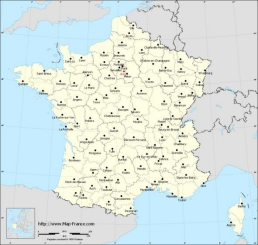
Department: Essonne
Total Area: 8.33 km²
Population in 2016: 54 663
Population Density: 6562 /km²
Location: Évry is a large city in central northern France. The town is located in the Essonne department in the Île-de-France region. Évry is approximately 17 miles (27 km) southeast of Paris and is one of several new towns developed outside the capital since 1965.The city of Évry zip code is 91090 or 91080 or 91000 and its INSEE code is 91228. The inhabitants of Évry are called Evryens and Evryennes.
Histogram of demographic change
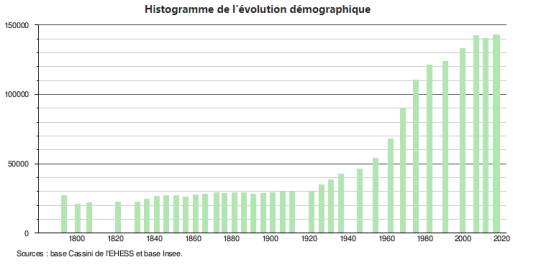
Sources :http://www.cartesfrance.fr/carte-france-ville/91228_%C3%89vry.html
https://www.britannica.com/place/Evry
II.Natural Geography
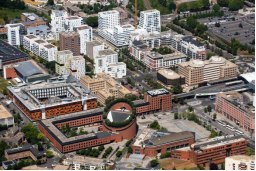
Geographical environment: Located on the left bank of the Seine, Évry is one of the greenest cities in France with many green spaces and other parks that diminish the strong impact of the buildings that dot the city of Ile-de-France. Very well served by public transport, Évry is an ideal point to discover the beauties of the Île-de-France, and more particularly of the capital, Paris. Dynamic and full of animations, the city of Évry knows a cultural and sporting offer of the most interesting with festivals, sports events or various manifestations of all kinds. Built mostly in the last thirty years, Evry still has some beautiful monuments that recall its past and previous centuries scattered throughout the city.
Climat: Évry enjoys a degraded oceanic climate with cool winters, mild summers, and with regular watering throughout the year. The annual gross average temperature is 10.8 °C, with a maximum average of 15.2 °C and a minimum average of 6.4 °C. The average monthly extreme temperatures recorded are 24.5 °C in July at the maximum and 0.7 °C in January at the minimum. Due to the lower urban density between Paris and its suburbs, a negative difference of one to two degrees Celsius is felt, especially at the start of the day. The average sunshine time can reach up to two hundred and forty hours in July and low to fifty-three hours in December. Precipitation is evenly distributed over the year, with an annual total of 598.3 millimeters of rain and an approximate average of fifty millimeters per month.
Transport: The regional rapid transit RER line D forks just south of Évry into two branches, encircling Évry and the commune of Ris-Orangis before merging into one right-of-way again 11 kilometres north of the fork. Évry is served by three stations along the two branches: Évry-Val-de-Seine, Évry–Courcouronnes Centre, and Le Bras-de-Fer. The line that serves the station Évry–Courcouronnes Centre and Le Bras-de-Fer was built at the same time as the new town. The town is bordered to the west by the A6 motorway, south by the National 104, and the National 7 running north to south divides the town in two. The Seine marks the eastern limit of the town. A new port has recently been built to accommodate an increase in barge traffic. The local bus network is served by Tice operator, including lines 401, 402, 403 and 453, 404, 405, 407, 408, 414, 414D and 415. By night, Noctilien can be taken from Evry to Villeneuve-Saint-Georges station with line N135 and to Paris-Est station with line N144. Both stations are also deserved by the RER.
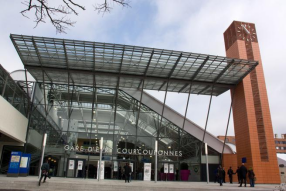
Sources : https://www.france-voyage.com/tourism/evry-1676.htm
III.Economy
Évry is one of the economic poles of the department and the region, it is the center of the employment area defined by INSEE.
According to Insee, in 2014, the inhabitants of Évry earn on average € 2,280 net per month, or € 27,355 net per year.
Port of Évry: One kilometer along the Seine, Évry has a commercial port, directly connected to the Francilienne and to the Paris-Sud. Installed on a surface of more than four hectares, it can treat 154,600 tons of goods.
A total of 287 companies are located in the city, enabling 32,353 Evryans to work in the city, of which 29,621 are in the service industry and 1,896 in the industry.
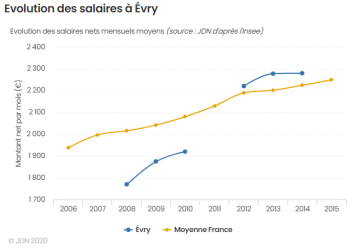
Evolution of average monthly net wages
Sources : http://www.journaldunet.com/business/salaire/evry/ville-91228
IV.Industrial Characterisitics
Évry is a centre for a wide range of business services. It has a university and a large central retailing and leisure complex. Various industrial estates and office parks were developed as an integral part of the new town. Industries include food processing, printing, and the manufacture of machinery and electronics. Research-based activities have also been established in Évry, particularly in the biotechnology and space fields.
Food processing:Ynsect SAS( a biotechnology startup company. The Company designs, builds, and operates insect production and processing facilities for the production of feed for fish and poultry. YNSECT has 100 employees at this location and generates $152,204 in sales (USD).)
Manufacture of machinery and electronics:MAYSER FRANCE (part of the Household Appliance Manufacturing Industry. It generates $1.42 million in sales (USD). )
Biotechnology: Genethon (a French laboratory founded by the French Anti-Myopathy Association in 1990, is dedicated to the design and development of gene therapy products for rare diseases.)
Space: Arianespace SA (a multinational company founded in 1980 as the world's first commercial launch service provider. It undertakes the operation and marketing of the Ariane programme.)
Sources: https://www.britannica.com/place/Evry
https://www.genethon.fr/
https://www.dnb.com/business-directory/company-profiles.mayser_france.a54b796806c54fd858d7c95761789c28.html
V.Attractions
1.Castle of Petit-Bourg
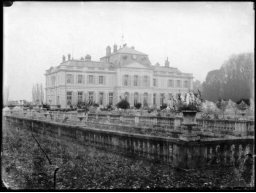
Introduction: Castle of Petit-Bourg was a French castle residential castle located in Evry-sur-Seine in Hurepoix countries, on the left bank of the Seine, in the present department of Essonne and the region Ile-de Current La France.
History:
The first castle known on the Petit-Bourg site overlooking the Seine, to the forest of Senart, was started in the early seventeenth century to André Courtin, canon of Notre-Dame de Paris and completed around 1635 for Jean Galland. Around 1650, Bishop Louis Barbier, bishop of Langres, had him decorate gardens designed by François Mansart. Mansart would have worked around 1662. 1695, Madame de Montespan acquired the Château de Petit-Bourg. She did make major development works and instructed André Le Nôtre to design gardens in the French, stepped terraces. She took refuge there after his disgrace. At his death in 1707, his son the Duke of Antin, inherited the castle and made remake gardens. Between 1716 and 1722 he undertook to do completely rebuilt by architect Pierre Cailleteau said Lassurance. The new castle of Petit-Bourg was a truly princely residence masterpiece Lassurance. The best designers of the time worked there. It particularly noted the firm gallery of the King's apartment and the large living room, decorated by François-Antoine Vasse portraits of royal and ducal emblems.Before reconstruction of the castle, the Duke d'Antin received in Petit-Bourg Louis XIV and, in 1717, Czar Peter the Great. After its reconstruction, Louis XV and Queen Marie Leszczyńska made frequent visits there. Madame de Pompadour saw his land Etiolles before being elevated by royal favor, and dreamed of this magnificent home. After the death of the Duke of Antin, the castle survived, unfurnished, for several years.
Acquired by Marie Jacomel, widow of Louis Chauvelin, president mortar parliament of Paris, he was completely demolished in 1750 and replaced by a new castle built from 1756 in neo-classical style, designed by architect Jean-Michel Chevotet. At the time of the Revolution, the castle was owned by the Duchess of Bourbon, born Bathilde d'Orléans. After passing through several hands, it was acquired in 1827 by the banker Alexandre Aguado, Marquis de Las Marismas, who welcomed them his friend, the composer Gioachino Rossini, who composed partly his opera William Tell in the summer of 1828 and had himself elected mayor of Evry-sur-Seine in 1831. the creation of the Paris railway Corbeil came unfortunately cut the park in two and separating the Seine. Alexandre Aguado sold his property April 7, 1840 to speculators who undertook to divide the field. The Germans occupied the castle during World War II, and burned it in 1944, when they left Evry. The ruins were razed. At the site of the castle was built the residence of the "Park of Petit-Bourg". The driveway lined with chestnut and lime trees along the pavilions of the residence was the avenue of honor of the castle.
Sources : http://www.frenchchateau.net/chateaux-of-ile-de-france/chateau-de-petit-bourg.html
2.Évry Cathedral

Introduction: Évry Cathedral is a Roman Catholic church. The cathedral of the Resurrection was built between 1992 and 1995 by the swiss architect Mario Botta. It is dedicated to St Corbinian, born near Évry in 680, and evangelist of Bavaria. It cost 13 million Euros to build.Évry Cathedral opened its doors to the public on 11 April 1995, was dedicated on Easter 1996, and was visited by Pope John-Paul II on 22 August 1997. Self-directed tours of the cathedral with audioguides and group tours are available daily, including Sunday.
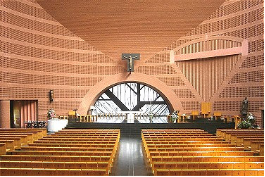
It has the shape of a truncated cylinder with a diameter of 38 m (125 ft) rising to 34 m (111 ft). The walls are covered with 800,000 bricks forming geometrical designs. The top is crowned with twenty-four lime trees, symbol of life. The metal bell-tower at the top, has five bells. The cathedral is next to a series of buildings with the form of a cloister. The nave is a vertical cylinder of 29 m (95 ft) in diametre built in bricks. The ground is covered in black granite. The glass part between the roof and the walls enables a natural vertical lighting.
At the back of the chancel, a window symbolises a tree. The marble altar lies on a column which stands in the crypt. Above, the Christ was made in Tanzania at the beginning of the 20th century. At the front of the choir, the marble baptismal font enables baptisms by immersion. It is dominated by a statue of the Virgin Mary in wood, dating from the 16th century. On the right, the cathedra, the bishop's see, is enhanced by a special brick decoration. A bronze statue represents St Corbinien. In the ramp leading to the choir, the Way of the Cross is made up of three sheets of petrified wood from the Arizona.
Source: http://cathedrale-evry.net/textes/english.htm
3.Castle of Beauvoir
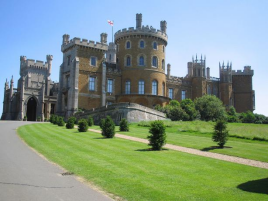
Introduction: Overlooking the quiet and restful landscapes of the hedged farmland of the Besbre Valley from the top of its hill, the 14th and 15th-century Beauvoir Castle located in the commune of Saint-Pourçain-sur-Besbre is surrounded by beautiful French-style gardens which are ideal for a leisurely stroll. The castle's name means beautiful view. It is a Grade I listed building. The castle remains privately owned, but is open to visitors.
Histroy:
(1)First castle
A Norman castle originally stood on the high ground within the wapentake of Framland, overlooking the adjacent wapentake of Winnibriggs. in Lincolnshire and dominating both.It was built on the land of Robert de Todeni of the Doomsday Book, and inherited from him by William d'Aubigny. It then eventually passed to William's granddaughter Isabel, who married Robert de Ros circa 1234.
Belvoir was a royal manor until it was granted to Robert de Ros in 1257. He was given a licence to crenellate in 1267. When the legitimate de Ros line died out in 1508, the manor and castle passed to George Manners, who inherited the castle and barony through his mother. His son was created Earl of Rutland in 1525.
(2)Second castle
The Norman castle had been in ruins since 1464 and in 1528, Thomas Manners, 1st Earl of Rutland started construction of a new castle. It was completed in 1555. Much of the stone for this building came from Croxton Abbey and Belvoir Priory following their dissolution.
In the early 17th century, castle servants Joan, Margaret and Phillipa Flower were accused of murdering the 6th Earl's two young sons by witchcraft. Joan died while in prison and Margaret and Phillipa were hanged.
During the English Civil War, it was one of the more notable strongholds of the king's supporters and King Charles spent a night here on his way into Lincolnshire.
(3)Third castle
In 1649, the castle was destroyed by Parliamentarians. A new building was started in 1654 which was designed as a large family home by the architect John Webb. Work was completed by 1668 and cost £11,730 (£2.03 million today).
The 9th Earl was created Duke of Rutland in 1703. Belvoir Castle has been the home of the Manners family for five hundred years and seat of the Dukes of Rutland for over three centuries.
(4)Fourth castle
In 1799, the 5th Duke of Rutland married Lady Elizabeth Howard. The new Duchess of Rutland soon chose architect James Wyatt to rebuild the castle in the romantic Gothic Revival style. The Duke, one of the wealthiest landholders in the United Kingdom of Great Britain and Ireland, sold seven assorted villages and their surrounding lands to fund the massive project. The project was nearing completion when, on 26 October 1816, it was almost destroyed by a fire. The loss - including pictures by Titian, Rubens, Van Dyck, and Reynolds - was estimated at £120,000 (£9.25 million today).
Whilst visiting Belvoir castle in the 1840s, Anna, Duchess of Bedford, found that the normal time for dinner was between 7:00 and 8:30 p.m. An extra meal called luncheon had been created to fill the midday gap between breakfast and dinner, but as this new meal was very light, the long afternoon with no refreshment at all left people feeling hungry. She found a light meal of tea and cakes or sandwiches was the perfect balance. The Duchess found taking an afternoon snack to be such a perfect refreshment that she soon began inviting her friends to join her. Afternoon tea quickly became an established and convivial repast in many middle and upper class households.
4.Belvoir Gardens:
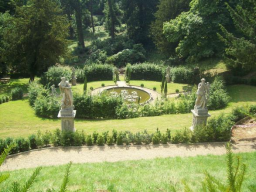
Belvoir Gardens was designed and landscaped by Elizabeth Howard, 5th Duchess of Rutland, who was married to John Manners, the 5th Duke of Rutland. It was created in 1799, the year Belvoir Castle was built. There are many unusual features to the gardens, for example the natural amphitheatre which faces the estate was formed by the moraines of glaciers and a 'root house' or summer house which survives to this day. These natural amphitheatres are now embedded with fresh water springs to ensure blooming plants throughout the year.
Belvoir Gardens was also the first site of mass spring flower bedding, a concept developed by Mr. Divers, head gardener of the gardens at the time.
The once thriving gardens are now slowly being restored to its former glory. "Friends of Belvoir Gardens" is a programme which encourages enthusiasts with green fingers to volunteer to help manage this beautifully preserved garden.
Source: https://www.france-voyage.com/tourism/beauvoir-castle-1759.htm
https://historicengland.org.uk/listing/the-list/list-entry/1360870
VI.History
In 1965 Évry became part of the French new town initiative and took its current name. Before then it was known as "Évry-Petit-Bourg" and had a population of only a few thousand. When Évry was built, Orly was the primary international airport of France, and many international companies such as Digital, Hewlett-Packard, and Alstom established their head offices in Évry. However, with the expansion of Charles de Gaulle Roissy airport, all the larger companies have moved out, causing the downfall of the many smaller service companies which catered to the lunchtime needs of the thousands of staff who were either displaced or made redundant.
On 31 January 2006, in the Sénat during the 14th ceremony of the "Prix du Trombinoscope 2005" (press awards), Manuel Valls was elected "Local Representative of the Year". With the heavy defeat of the Socialists on the national scale during the 2007 elections, Manuel Valls has taken a prominent position in the party and has been given the nickname of "Le Sarko de la gauche" (the left wing Sarkozy).
VII.Other information
The new town of Évry was built mainly at the end of the 20th century and at the beginning of the 21st century. Besides, Évry is a Green City, offering its visitors a large number of green spaces of all kinds. On the territory of the commune, there are about one hundred hectares of parks such as Henri Fabre Park, the Parc des Loges, the Coquibus Park, the Tourelles Park, the Battle Park, the Pompidou Park, the Seine River Park, the wild wood or the square of the Resistance. Thanks to all this greenery, Évry obtained a reward of three flowers in the contest of the cities and flowered villages of France.
Sources : https://www.france-voyage.com/tourism/evry-1676.htm
VIII.Contact information
Address of Évry town hall:
Mairie de Évry
Place des Droits-de-l'Homme-et-du-Citoyen
91011 Évry Cedex
Phone number: 01 60 91 63 98
Fax: 01 60 78 51 77
Website: http://www.mairie-evry.fr
Mayor : Francis Chouat (Mandat : 2014-2020)
Sources : http://www.cartesfrance.fr/carte-france-ville/91228_%C3%89vry.html#mairie
